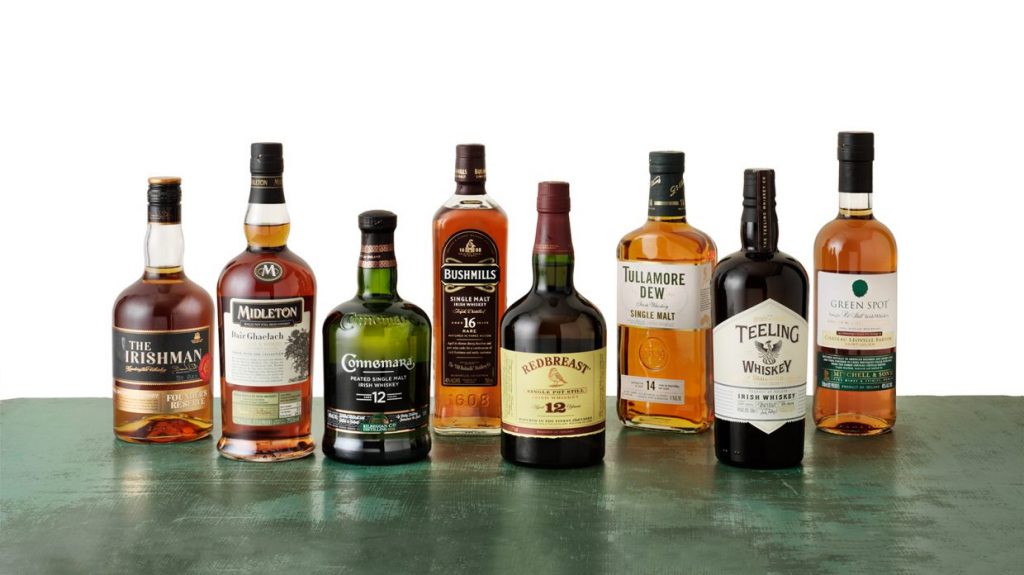Irish whiskey is the sensible alternative for stocking a home bar with high-end product.
Older age statements, innovative techniques, and creative finishings are hallmarks of a liquid that’s evolved beyond Jameson.

This was an underwhelming year for St. Patrick’s Day spending, but it remains a spectacular time for Irish whiskey fans. The category is one of the fastest-growing spirits segments in the U.S., with a compound annual growth rate of 13.4% over the past five years, according to IWSR Drinks Market Analysis; domestic whiskey has grown 5.5%, Scotch whisky 0.2%.
Much of that expansion is driven by sales in the super premium range, bottles that cost more than $30. Americans are not only drinking more Irish whiskey, they’re drinking better Irish whiskey. Generally soft and rounded, it’s unpeated, with hints of caramel oakiness and a light fruitiness against a cereal backbone. In its finest expressions, the country deftly demonstrates a primary selling point: the sophistication and structure of Scottish single malt bound by the sweeter approachability of bourbon.
And in this especially boozy moment—Nielsen reports that online liquor sales surged 234% in March—Irish whiskey still stands as a bargain compared with its counterparts in Scotland and Japan, making it a sensible alternative for stocking the home bar with high-end product.
The Dead Rabbit Irish Whiskey
Dublin Liberties Distillery makes this whiskey in conjunction with New York’s Dead Rabbit Grocery & Grog—named world’s best bar in 2016. First released on the tavern’s fifth anniversary in February 2018, it serves as an easy bridge for fans of the American stuff. After a half-decade of slumber in bourbon casks, the spirit is finished in virgin oak, leaving a whisper of nutmeg-cinnamon barrel spice in each sip. Consider subbing it for bourbon or rye in an Emerald Isle-themed Manhattan. $40
Kilbeggan Single Pot Still
A style of whiskey unique to Ireland, “single pot still” must be conceived at one distillery and only from a mix of malted and unmalted barley; 19th century recipes often included a small percentage of oats as a crafty way to skirt punitive taxes from the British crown. (The “pot” itself is a misnomer; as with single malts, it can still be a blend of different barrels of distillate.) Kilbeggan revived the tradition with a burnt honey-hued spirit that’s elegant in structure, yielding a creamy mouthfeel from the grain, with a slight grassy finish. $45
Teeling 24-Year-Old Single Malt
Perhaps no one man has done more to elevate Irish whiskey than John Teeling. The founder of Cooley Distillery has been laying down high-quality malt and grain in unconventional casks since the mid‑1980s. Today, his sons Jack and Stephen are creating their own legacy with an eponymous operation in the historic Liberties neighborhood of downtown Dublin. Evidently, they even procured some of Dad’s barrels. Among their most elegant releases is this limited-edition reserve that spent time in ex-Sauternes French oak. What pours out is a curiously tropical dram with hints of pineapple and marzipan, broadening the Irish category for a new generation of drinker. With only 5,000 barrels in existence, a connoisseur would pounce before stores run dry. $500
Redbreast 27-Year-Old
Redbreast leaped into the international spotlight when it came back to market in 1991, after a six-year absence. In March, the Cork-based bottler unveiled its oldest expression yet. The cask-strength offering derives its complexity from the merging of three distinct maturations: sherry butt, bourbon cask, and port pipes. They are then blended in precise proportion to arrive at a rich whiskey with ripened red-fruit aromas that offset a sustained palate of toffee and dates. A smooth sip leaves scant evidence of its triple-digit proof. $500
Bushmills 21-Year
To many drinkers, single malt and Scotch are almost synonymous. This bottle smashes that stereotype. It takes two distillates—one matured in ex-bourbon barrels, the other in oloroso sherry butts—and marries them in Madeira wine casks. The result is an ode to sultanas and Christmas fruitcake, with a stubbornly persistent finish of spiced pepper. It easily stands up to its Scottish brethren, with one notable point of separation: a reasonable price point for liquid this old. $249
Roe & Co. Blended Irish Whiskey
As a testament to the category’s turn of fortune, spirits behemoth Diageo Plc recently invested more than $27 million in a proper distillery in the heart of downtown Dublin. Although it opened to visitors last summer, you’ll have to wait a wee bit longer for a taste of what it will produce: Irish whiskey must spend a minimum of three years in the barrel. Until then, the brand’s first release, distilled elsewhere, is a soft, vanilla-laden blend of malt and grain whiskeys—and it does quite nicely. $33